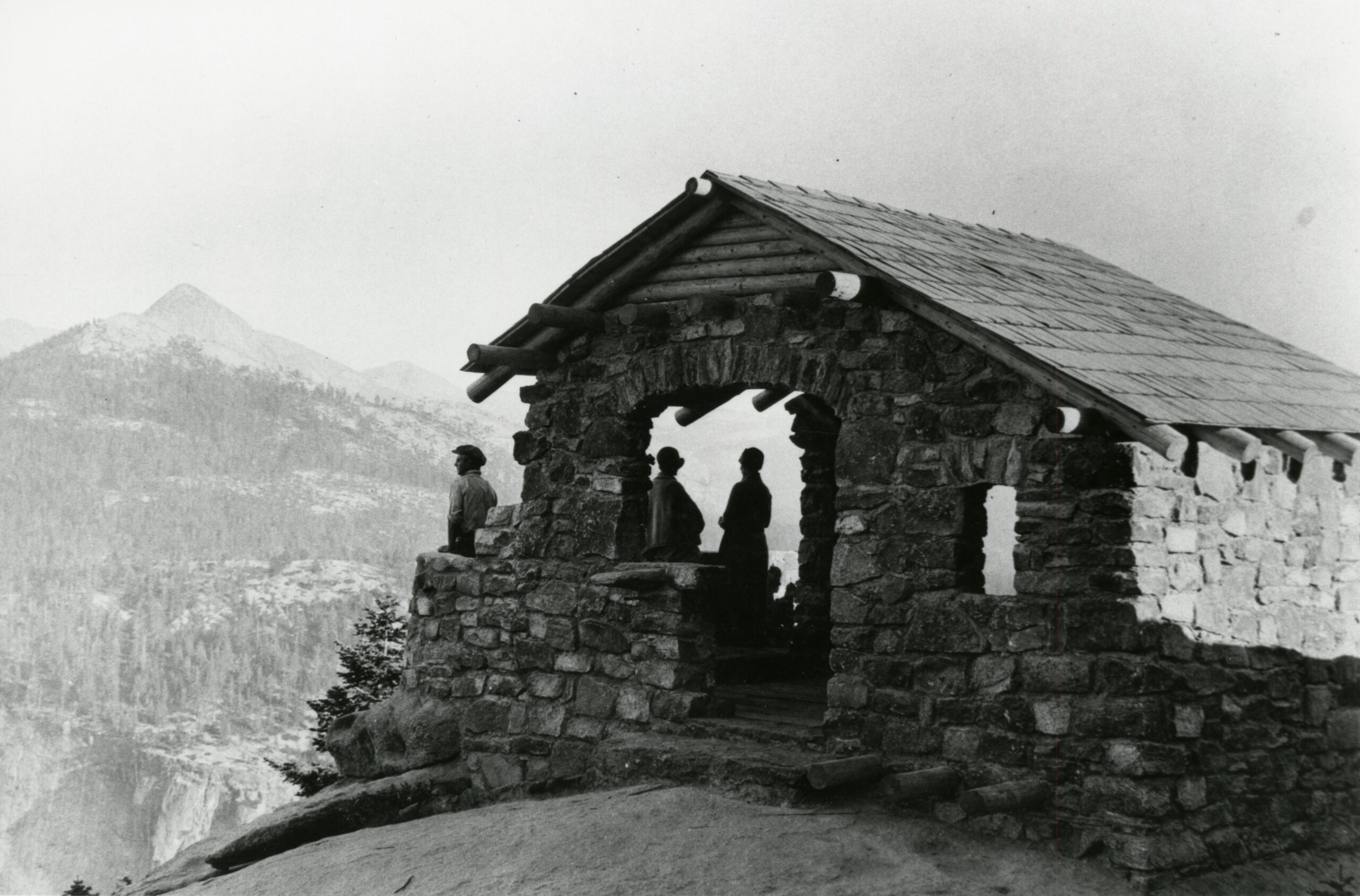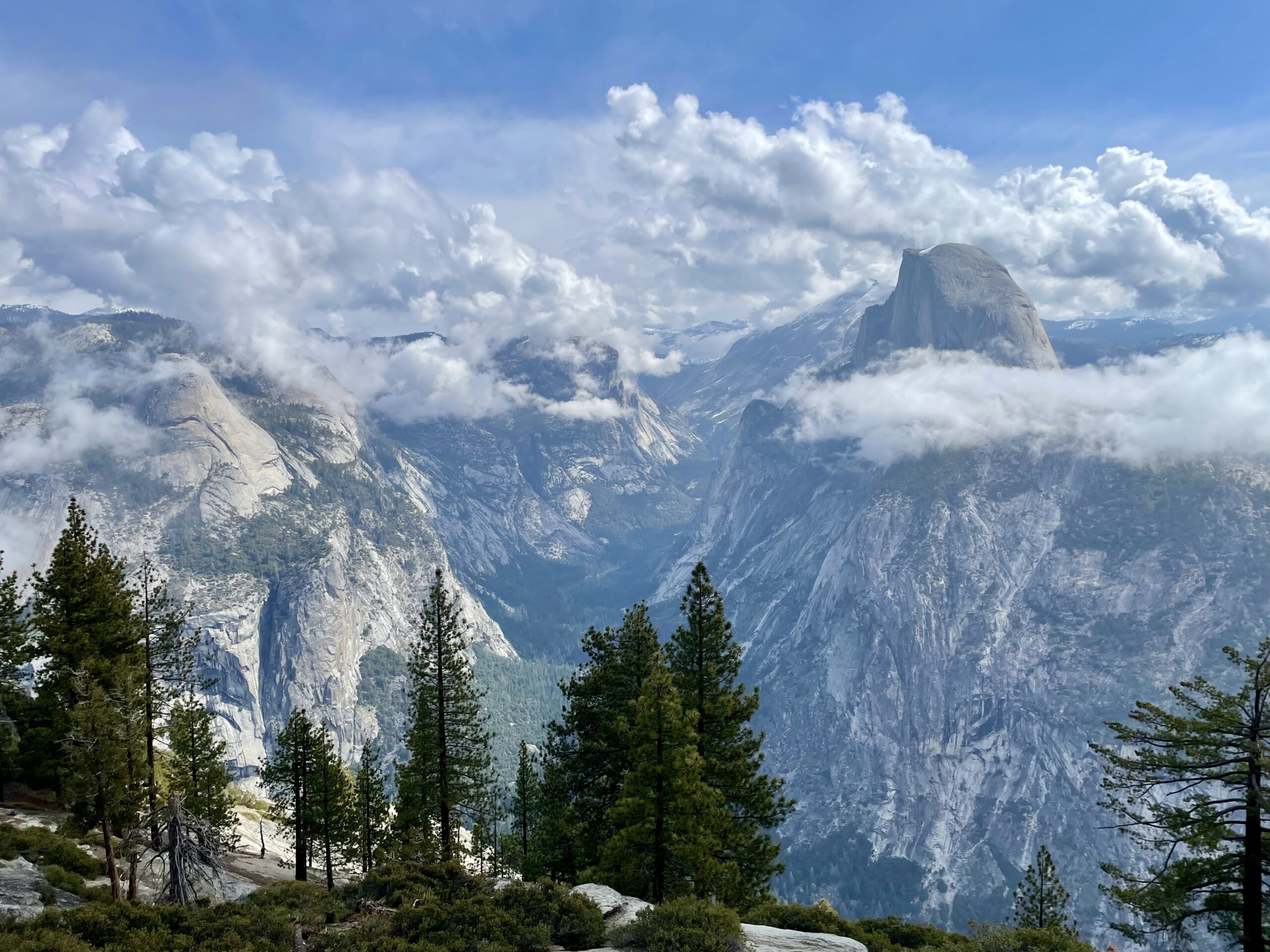This article appeared in our 2025 Spring/Summer Magazine. Read all our magazines here.
High above Yosemite Valley, a small stone hut sits peacefully among the trees on the edge of Glacier Point. At first glance, the Geology Hut is quite unassuming, with its stone walls and timber roof that mimic the natural architecture of the surrounding landscape.
Once inside the hut’s century-old walls, however, you’ll begin to understand its purpose. Exhibits teach visitors about Yosemite’s geologic history and importance, and through the hut’s large arched windows, these geologic wonders can be observed with inquisitive eyes.
Yosemite Valley stretches below. To the east, the Valley splits in two: The southern Merced River Corridor showcases cascading waterfalls and remnants of Yosemite’s historical glaciers, while the northern Tenaya Canyon carves a path between Mount Watkins and Clouds Rest.
As permanent and grand as this view feels, the truth is that long ago — before the Geology Hut was built as the National Park Service’s first “Trailside Museum” in 1925, before the designation of Yosemite National Park in 1890, and even before people inhabited this land — these marvelous valleys and canyons didn’t exist.

Historic photo of the Geology Hut at Glacier Point, taken relatively soon after it was constructed in the 1930’s. Photo courtesy of the National Park Service.
Yosemite’s Geologic Timeline
Previous age estimates for Yosemite Valley ranged from 3 million to more than 50 million years old. Some geologists hypothesized the canyon must be as old as the long-standing Sierra Nevada range, while others thought the shape of the Valley suggested it was created by glaciation much more recently.
“There are some ideas that Yosemite Valley is tens of millions of years old, and I’ve always had some trouble with that,” says park geologist Greg Stock, who has lived and worked in Yosemite for nearly 20 years. “The steep Valley walls are composed of fresh-looking granite that experiences rockfalls every few days. To me, that suggests a youthful landscape.”
It wasn’t until the late 2000s that a new canyon-dating technique was developed, finally allowing geologists to determine a more precise age estimate for the view from Glacier Point.
The method — known as helium-4/helium-3 thermochronometry — relies on a simple principle: Rocks are hotter the deeper they are underground, and they cool as erosion strips away overlying layers. These temperature changes leave a measurable record of helium trapped within the rock minerals. By analyzing that record, researchers can reconstruct the temperature history of a rock and approximate the time when the rock was carved and exposed.
In 2010, glaciology professor and researcher Kurt Cuffey from the University of California, Berkeley, joined forces with Stock and others to apply this new technique in Yosemite. While they couldn’t date Yosemite Valley itself — because the Valley’s rock bottom is unreachable at 2,000 feet under a sandy floor — they were able to date the adjacent Tenaya Canyon, which, given its close geological ties to the Valley, is likely around the same age.
“Yosemite is a spectacular place, but geologists have never been able to rigorously pin down when the canyon was formed,” Cuffey says. “Until our study, it was all just assumptions.”

Tenaya Canyon as viewed from the Geology Hut at Glacier Point. Photo courtesy of the National Park Service.
The team compared granite from the canyon’s rim with granite from its floor. The upland rocks revealed long-stable, cool temperatures, indicating that the high plateau has remained largely unchanged for tens of millions of years. But the canyon-floor rocks revealed a very different story: they were still warm about 10 million years ago, then cooled rapidly between 10 million and 5 million years ago — evidence that Tenaya Canyon was carved deeply during that window of time.
In 2023, after years of modeling and analysis, Cuffey and his team published their findings: Tenaya Canyon is geologically young, with an estimated age of only 5 million to 10 million years.
“Five million years seems like a really long time, but in the context of an Earth that is 4.5 billion years old, that’s just a tiny, tiny fraction of time,” Stock says.
Given these younger estimates, Cuffey and Stock believe the area was once a shallow valley. Then, 5 million to 10 million years ago, a river began to slice into the canyon floor and initiate the carving of Tenaya Canyon. A couple million years later — likely 2 million to 3 million years ago — the climate cooled, and glaciers came down through Tenaya Canyon into Yosemite Valley. These glaciers further sculpted the canyon walls and reshaped the landscape into what we see today, including Yosemite’s iconic peaks and monoliths.
Geology Still Unfolding
One of these iconic spots, Glacier Point, has given pause to scientists for centuries. Looking down on
Yosemite’s deep canyons, the mind questions how and when such a marvelous feature formed … it’s no wonder that Cuffey and Stock spent the past two decades researching just that.
The overlook sparked such awe that early scientists wanted to share these ideas with the public by building the Geology Hut, which was funded by the Yosemite Natural History Association — now Yosemite Conservancy.
Cuffey and Stock, alongside granite specialist Allen Glazner and others, are continuing this work by revitalizing the 100-year-old Geology Hut’s informational panels with updated scientific knowledge, including their recent geologic findings.
“The old displays in the hut were in serious need of updating since the science has progressed so much over the past several decades,” Stock says. “Development of the new displays is also coinciding with the rehabbing of the hut itself … remortaring the stones, replacing the roof and beams. The combined projects will revitalize one of Yosemite’s most beautiful sites.”

Conservancy donor Nadine Tang, geologist Greg Stock, and model artist Eric Knight examine and discuss the new bronze elements created for the updated Geology Hut displays. Photo courtesy of Eric Ball.
The project builds on the hut’s long history of using interpretive displays for visitor education and is made possible, in part, by Conservancy donors. One of the project’s biggest donors, UC Berkeley adjunct faculty member Nadine Tang, found her way to funding the hut through auditing one of Cuffey’s geomorphology courses, in which he highlights his work in Tenaya Canyon and the joys of exploring geologic landscapes.
“While I have always been awed by the beauty of nature and landscapes, it wasn’t until I got to know Kurt Cuffey that I became curious about how these landscapes were formed,” Tang says. “It is my hope that the new Glacier Hut elements will enrich the experiences of those fortunate enough to set eyes on it.”
Those who look inside and outside the Geology Hut are not just witnessing the grandeur of Yosemite; they’re looking into a geologic story that’s still unfolding. Thanks to the passion of researchers and supporters alike, this small stone hut continues to invite big questions, spark curiosity, and deepen our understanding of one of Earth’s most awe-inspiring landscapes.



